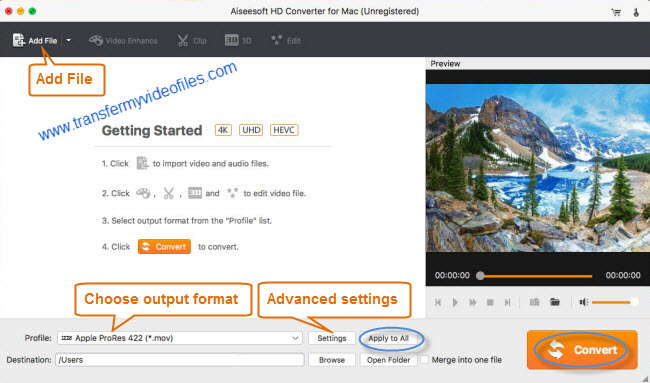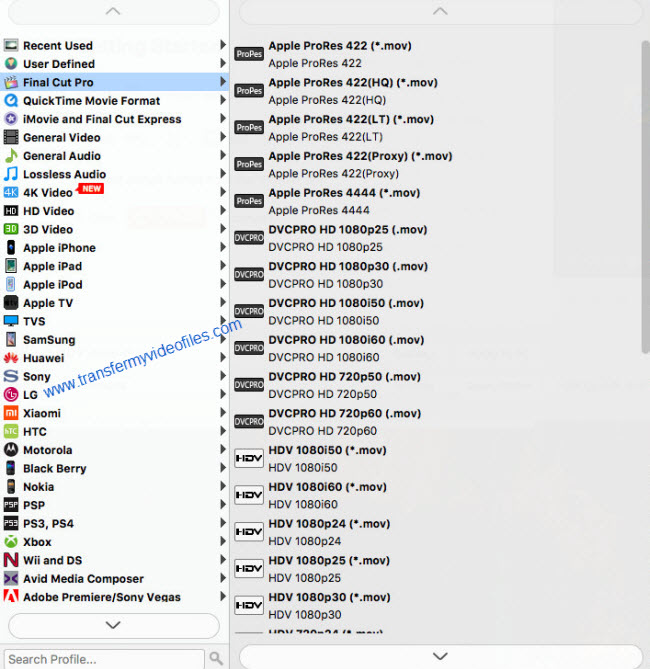This post shows you an easy-to-use and affordable DNxHD to ProRes Converter app to transcode DNxHD in MXF wrapper to ProRes for use in Final Cut Pro X with excellent quality.
Does anyone know a good DNxHD to ProRes converter?
“Hi, everyone, I was given DNxHD .MXF files to import to FCP X. I can Log and Capture DNxHD .mxf, MTS, ect files to FCP X for editing, but the importing process will need a lot of rendering time, so I needed something else to transcode the DNxHD MXF files to ProRes 422, FCP X’s native editing format before start. Does anyone know a good DNxHD to ProRes converter that would maintain original quality of the .mxf files? I would really appreciate any help. Thanks in advance.”
If you are having the same issue as mentioned above, you can give HD Video Converter for Mac a shot. This app features powerful ability to rewrap video files from one format to another preserving excellent quality, including encoding DNxHD .mxf to ProRes for FCP X, FCP 6/7, converting XDCAM MXF to DNxHD for Avid, Premiere, transcoding AVCHD, XAVC S 4K, 4K MP4 for editing in iMovie, FCE, FCP, Avid systems, DaVinci Resolve, Edius, Sony Vegas and more. Read on to find a step-by-step guide talking about how to rewrap DNxHD .mxf to ProRes 422 for working with FCP X with lossless quality.
[Guide] How to rewrap DNxHD .mxf to ProRes 422 for working with FCP X with lossless quality?
First of all, download a trial of HD Video Converter for Mac

Then follow these steps:
Step 1: Run HD Video Converter for Mac as a professional DNxHD MXF to FCP X Converter. When its main interface comes up, click ‘Add File’ to load source video to it.

Step 2: Select ‘Apple ProRes 422 (*.mov)’ as output format for opening with FCP X
From the Format bar, move to ‘Final Cut Pro’ catalogue, and select ‘Apple ProRes 422 (*.mov)’ as target format. Apple ProRes is the best suited editing codec for FCP X and its former version FCP 6 and FCP 7. When loading them into FCP X, you needn’t wait for a long time for rendering. To create smaller files, transcode your source files to Apple ProRes 422 (LT).

Apple ProRes 422 – Higher quality than Apple ProRes 422 (LT);
Apple ProRes 422 (HQ) – Keep original video quality for editing in FCP;
Apple ProRes 422 (LT) – Get a smaller file sizes than Apple ProRes 422;
Apple ProRes 422 (Proxy) – SD levels – 480i/p and 576i/p. Used in offline workflows.
Apple ProRes 4444 – Edit and finish 4:4:4 material.
Important: If you’ve loaded a number of video clips to do batch conversion, please do remember ticking off ‘Apply to All’ option before you start.
Step 3: Adjust video and audio settings (for advanced users)
If necessary, you can click ‘Settings’ button and go to ‘Profiles Settings’ panel to modify video and audio settings like video encoder, resolution, video bit rate, frame rate, aspect ratio, audio encoder, sample rate, audio bit rate, and audio channels. 3D settings are also available.
Step 4: Click ‘Convert’ to start DNxHD MXF files to ProRes MOV conversion.
Step 5: Click ‘Open Folder’ to get generated ProRes QuickTime files for transferring and editing in Final Cut Pro X with optimum performance.
Related posts
Why Adobe Premiere Pro CS6 can’t import MXF video files?
How can I import MXF footage into Avid Media Composer?
FCP 7 not recognizing my MXF file – convert MXF to ProRes
Convert P2 MXF to ProRes for FCP 6/7/X without losing sound
MXF and Vegas – How can I edit MXF video files in Sony Vegas?
